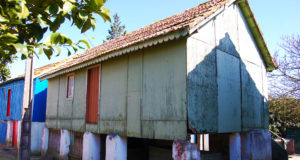
2 Hours/10kms
Easy Level
This proposal is a tour around the parish where the Marchanta is inserted. We will visit the other 3 villages, culminating in a visit to a heritage at risk, which served as the basis for Alves Redol’s book: “Avieiros” (*). The title of the book is the name given to the fishermen of the sea of the region of Vieira de Leiria, who migrated to the banks of the river Tejo and settled in first instance in their own boats, and later in palafites constructions.
Along the way we will pass in the village of Valada that dazzles us with its architecture and view over the river, through Reguengo, a small village in the countryside and finally we arrive at Palhota, a village with vernacular architecture.
* To ensure the guided visit to Palhota and it’s heritage contact:
Ass. Proj. Palhota Viva
Palhota – Valada do Ribatejo
(+351) 963 752 615/(+351) 926 564 424
palhotaviva@gmail.com
THIS PROPOSAL INCLUDES A VISIT TO THE LOCAL HERITAGE.
Exit the Marchanta through the gate on the river side, turning to the right with the dam on your left. The route will always be straight ahead along the narrow tar road, on the way to Valada at 2,5kms.
A small warning for a situation to take into account, midway, where the road lined the Epal facilities. At this point you can choose the route by the road, where you have to take into account that the traffic is done in both directions and the road is narrow, or you can choose to go on the top of the dam, but where you have to take into account a pillar at the entrance and the exit of this route. After going through this place, go ahead until Valada where we are going to delight with the view.
We are getting to Valada, to the rossio of the village, where it began. A ramp takes us up to the dike where we can stop to interpret what we see. On the right side we have a church of the thirteenth century, in the same place where a small castle once existed, when the Tagus River defined the southern border of Portugal.
The two great historical landmarks of this village were the “Peace Agreement of Valada” agreement signed between the Portuguese kingdom and the Castilian kingdom in the fourteenth century; and the “Kilometer launched of Valada”, one of the first car races that happened in the country, and that had the presence of the king in 1906.
On the side of the river, where once were a river port, there is now a marina where several boats dock. Let’s move on through the top of the dam, bypassing the portals from time to time.
Let’s take the opportunity to go down to the coffee shop just after the marina. Here we take contact with the locals and who knows, we will hear stories of the great cyclist Alfredo Trindade, twice winner of the Tour of Portugal.
In honor of this, we will continue our journey after having a drink. We return to the top of the dam to see both sides of the village. We go this way until we are forced going down to the road after the graveyard. Still, we will continue parallel to the dam.
We are now on our way to the picturesque village of Reguengo, where less than 100 people live. We have 2 kms ahead over the fields, where we can see crops of tomato, vineyards and corn.
We follow the road that itself takes the top of the dam. From here we can observe the picturesque architecture of the village. We continue until there is a road to the left to return heading the river.
We are going to follow a dirt road half a kilometer to our final destination. At our side, the cultures return to settle the lands. In the background the village of Palhota, wait for our visit. When we arrive, we recognize a peculiar architecture characterized by the house built on top of stilts, so that they are safe from the winter floods.
We rounded the village until we reached the small fluvial port, where we can see typical boats, the bateiras. The village was created by this people “Avieiro” who came from the seashore to live from fishing in the river. In the early days, the boats were their own dwellings, before they gradually set themselves.
We finished the visit at the museum house of Avieiro, where we will have the project Projecto Palhota Viva as host, and that will unveil the secrets of this community and how it lived.
The return will be done by the same way.